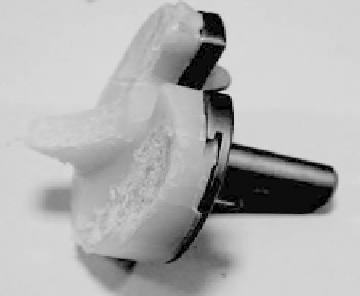Biomedical Engineering Reference
In-Depth Information
and these osteoclasts lead, in the long term, to the bone resorption around the prosthesis [68].
Increased concentrations of circulating metal-degradation products of fretting corrosion of the
metallic implants may also induce the bone resorption and have deleterious biological effects over
the long term [69]. Additionally to these negative biological effects, deformation and damage of
the implant materials disturb the stabilizing function of the implant. It was found, for instance, that
glenohumeral instability after arthroplasty was associated with the wear of the glenoid component
[70] (Figure 21.16b).
There are many factors that infl uence the material wear and degradation in TJRs (Figure 21.17).
Design and manufacturing process takes into account geometry of the prostheses, surface rough-
ness, loading characteristics, and lubrication condition. By comparing anatomical and artifi cial
joints, it can be concluded that while healthy human joints are lubricated by fl uid fi lm, all current
artifi cial joints with relatively hard-bearing surfaces are lubricated by the boundary and mixed
lubrication, which results in wear, and consequently wear debris from articulating surfaces [71].
Among the material factors, the material properties are crucial. However, details of manufacturing
process, sterilization, and handling may profoundly alter these properties. Design of the artifi cial
joints is of paramount importance. Insuffi cient thickness of the polyethylene component infl uences
wear of the TJRs.
Bartel et al. [72] indicated that in order to minimize wear, a minimum thickness of 8-10 mm
should be chosen for tibia component and 6-8 mm for acetabular components. Contact surface
geometry described by radial clearance (or degree of conformity) between the radii of curvature of
the articulating surfaces of components is another geometrical factor affecting the wear of implants.
Low joint conformity might result in high contact stresses and could contribute to faster implant
wear and failure. Swieszkowski et al. [73] reported that the peak stress generated in nonconforming
glenoid components under conditions of normal living can be as high as 25 MPa; since this exceeds
the polyethylene yield strength deformation, wear of the components can be expected.
The major factor responsible for the failure of polyethylene implants is oxidative degradation
of polymer induced by sterilization with γ-irradiation. The irradiation results in the generation of
free radicals in polyethylene. These free radicals may react with oxygen that could diffuse into
polyethylene during shelf storage or
in vivo
, causing the polymeric chain scission, which in turn,
will lower the molecular weight of PE, increase the density, stiffness, and brittleness, and reduce
the fracture strength and elongation to failure. Any of these changes could dramatically affect the
wear resistance [63].
Material fatigue could be the reason of the subsurface cracking in the polyethylene components
of the knee implants. These cracks very often propagate to the surface of the implants, causing the
fracture of the polymeric components. The fatigue and structure defects of the biomaterials may
(a)
(b)
FIGURE 21.17
Wear, oxidation, and fracture of the (a) tibia and (b) acetabular components.



